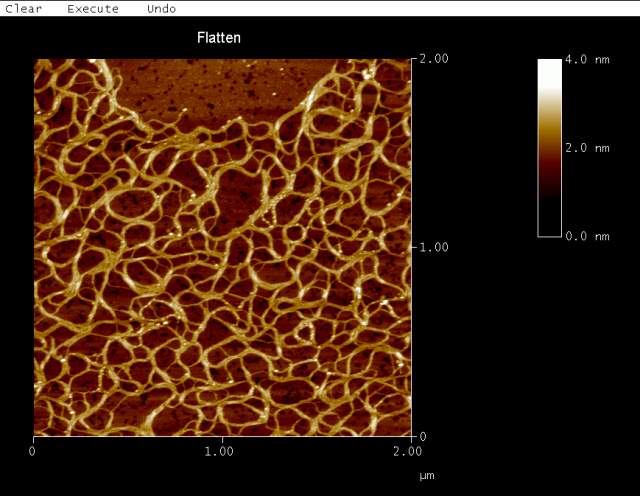Jan 24 2013
It stiffens when heated and retains moisture a hundred times better than other gels. Chemists at Radboud University Nijmegen have created a gel made from helical polymers. The molecules twist together to form a ‘nano rope’, from which strong, stiff networks are produced. What is unusual is that a solution of the material is liquid when cold and turns into a gel when warmed – exactly the opposite of what happens to gelatine, for example. The leading scientific journal Nature published a paper showing how the ‘super gel’ works and its properties on 24 January. Together with the business community, the researchers are also developing various biomedical applications for this extraordinary gel.
 Supergel nanowires forming a net, Radboud University Nijmegen
Supergel nanowires forming a net, Radboud University Nijmegen
Inspired by nature
The Nijmegen chemists Prof. Alan Rowan and Dr Paul Kouwer were inspired by the proteins that provide the cells in our bodies with their strength. Each cell contains thousands of these very thin but strong threads. They were able to mimic the winding structure of these proteins using a synthetic polymer - polyisocyanide (PIC). Kouwer: ‘We’ve made a copy that is almost exactly the same as the natural original, which is unprecedented. Not only is the structure of our material strikingly similar to the cell proteins, but the strength and sensitivity of the two materials are practically identical, even if you suddenly pull them hard.’ The structure provides the polymer with its unusual gel response – less than one gram of the solid substance needs to be added to a bucket of water to produce a strong gel. It therefore has a gel response one hundred times better than the commonly-used super gels (in nappies for example).
Stiffens when heated, melts in the refrigerator
What is also unusual about this substance is that it stiffens when the solution is warmed. The researchers show in Nature that the transition temperature of the solution can be varied between room temperature and body temperature, and the ability to adjust this temperature is very important in biomedical applications. The gel melts again when it is cooled.
Applications and patents
The structure of the gel implies huge opportunities for biomedical applications. Various options are being explored in partnership with Noviotech, a commercial partner of the Radboud University Nijmegen and Radboud University Nijmegen Medical Centre. Rowan: ‘One application is as a medium for the growth and manipulation of cells. Another potential application is in wound treatment. Once applied, the gel protects the wound: the microscopic structure allows fluid to pass through but keeps bacteria out. Once the wound has healed, the ‘plaster’ can be easily removed by cooling the gel.’ More and more possible applications for the super gel are emerging, with filters for nanomaterials and even cosmetic applications currently being investigated.
Fundamental and applied research
The paper published in Nature describes the fundamental properties of this unusual material. ‘When we first produced the material in the laboratory two years ago we knew that it was a very special substance, but did not yet understand why. The follow-up research has produced some fantastic results. And then I don’t mean just the publication of this paper, but also and especially the fact that the fundamental research has made the various applications much more feasible,' Prof Rowan states.